Nutrition
Children need good nutrition to grow into healthy adults. The American Academy of Pediatrics recommends healthy eating for children of all ages. Nutrition recommendations may be different depending on age and gender.
While your child is in the hospital, a registered dietitian (RD) will meet with you and your family to talk about the different kinds of foods eaten at home. The dietitian will ask about the foods and drinks your child has at breakfast, lunch, dinner, and snacks. Your family will then learn about healthy eating so that diabetes can be better managed. It is important to remember that nutrition recommendations for type 1 diabetes and type 2 diabetes may be different.
Nutrition and Carbohydrates
As part of the education, a dietitian will give your family instructions on how to count grams of carbohydrates. This is important because carbohydrates are the part of food which raises blood glucose.
Carbohydrates are in grains, like bread, rice, and pasta. They are also in milk, fruits, and vegetables. Carbohydrates are in foods with added sugar, like cake, cookies, and sweets.
The chart on the next page will help your family learn about the carbohydrate amounts in different foods.
| Grains: 15g of carbs per serving | Milk: 12g of carbs per serving |
|
1 slice of bread 1/2 hamburger or sandwich bun 1/2 cup plain oatmeal 4-inch pancakes 1/2 cup cooked rice or pasta 1, 6-inch tortilla |
1 cup white milk 1/2 cup chocolate milk 6-8 oz. plain yogurt |
| Starchy Veggies: 15g of carbs per serving | Meat and Protein: 0g of carbs per serving |
|
1/2 cup corn, peas or potatoes |
(non-breaded) chicken, fish, beef or pork eggs cheese |
| Non-starchy Veggies: 5g of carbs per serving | Fats: 1g of carbs per serving |
|
1/2 cup cooked green beans, broccoli, carrots, etc. 1 cup raw veggies |
margarine, butter, or oil 1 Tbsp. cream cheese 1 tsp. mayonaise 1 Tbsp. salad dressing |
| Fruit: 15g of carbs per serving | Sweets: 15g of carbs per serving |
|
1/2 medium banana 15 grapes 1 small apple or orange 1/2 cup 100% fruit juice 2 Tbsp. raisins |
2-inch unfrosted brownie (1 oz.) 2-inch unfrosted cookie (1 oz.) 1 Tbsp. jelly 1/2 cup vanilla ice cream 2-inch square unfrosted cake |
After you learn how to count carbohydrates, the meal plan can be much more flexible. It is important to know how to count carbohydrates, and we want to help. Our dietitians will work with your family while your child is in the hospital and at follow-up clinic visits. You will be given written information that will help your family learn more about carbohydrate counting.
Free Foods
A ‘free food’ is a food that is very low in carbohydrates. Typically, these foods have 5 grams (g) of carbohydrate or less per serving. Your child can have free foods for snacks to avoid giving an extra insulin injection.
Here are some examples of free foods:
-
Sugar-free Jell-O® topped with 2 Tbsp whipped topping
-
1 cup low-fat microwave popcorn
-
Celery with 1 Tbsp natural peanut butter or cream cheese
-
Pickles
-
1/2 cup cooked, non-starchy vegetables, like green beans, broccoli, or cauliflower
-
1/2 cup low-fat cottage cheese
-
1 sugar-free popsicle
-
1/2 cup raw vegetables, dipped in 1/4 cup salsa or 2 Tbsp guacamole
-
String cheese
-
Eggs
-
Turkey jerky

-
1/4 cup peanuts
-
20 almonds (Picture 1)
-
Deli meat
-
Chicken salad or tuna salad with celery sticks or in a lettuce wrap
Be careful of portion sizes of some free foods. They may be high in calories and fat. For healthy eating, try to stick with one snack between meals.
Insulin-to-Carbohydrate Ratios (ICR)
Insulin may be dosed using an insulin-to-carbohydrate ratio (ICR) at each meal. This will let your child eat the foods he or she enjoys, while still having good control of blood glucose. The amount of insulin given will be different based on how many carbohydrates are eaten.
To figure out an insulin dose, divide the total grams of carbohydrate that will be eaten by the ICR. The diabetes team will tell you how to round the insulin dose.
Some examples of ICR ratios and how to calculate insulin doses are in the chart below:
| ICR Prescribed by MD | Carbohydrate Grams (Example Meal) | C (carbohydrate from ICR) | Actual Calculated Number of Units of Insulin | Rounded to Whole Units of Insulin (see rounding rules) |
| 1:10 | 83 | ÷ 10 | 8.3 units | 8 units |
| 1:12 | 83 | ÷ 12 | 6.9 units | 7 units |
| 1:15 | 83 | ÷ 15 | 5.5 units | 6 units |
| 1:30 | 83 | ÷ 30 | 2.8 units | 3 units |
The diabetes team may also make changes to the ICR as needed. This will help to better manage blood glucose. In addition to using an ICR, it is still important to make healthy food choices, like eating lots of fruits and vegetables every day.
Nutrition Labels
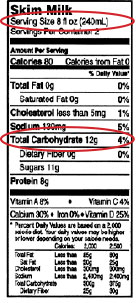
Reading food labels might be difficult at first, but there are only two things to look for when counting carbohydrates (Picture 2):
-
Serving Size – This is always listed at the top of the label.
-
Total Carbohydrates – This is listed in grams.
In Picture 2, the serving size for skim milk is 8 fluid ounces (fl oz). There are 12 grams (g) of carbohydrate in 8 fl oz of milk.
Remember to use measuring cups or measuring spoons to figure out the portion size. Portion size makes a big difference! If your child chooses to eat an amount different from the serving size listed on the nutrition label, this will also change the amount of carbohydrates in the food.
Example: How many grams of carbohydrates would you count if drinking 2 cups (16 fl oz) of milk?
1 cup (8 fl oz) = 12g carbohydrate
12g carbohydrate x 2 cups = 24g of carbohydrate
Once your family feels comfortable with doing this, the dietitian may go over harder label reading at future clinic appointments.
Other Foods to Think About
An ICR gives flexibility with the foods someone with diabetes can eat. However, there are a few things that the dietitians strongly encourage not eating. These foods include regular soda, pop, and syrup, like maple syrup or pancake syrup. This is because they are made of a lot of sugar. These two things can make blood glucoses go very high, very quickly. There are many other options! Choose drinks with zero grams of carbohydrate, like diet soda pop, sugar-free powdered drink mixes, or flavored water. Plain water is always one of the healthiest options you can give your child as a drink to hydrate. Try adding slices of fresh fruit to plain water, like oranges, lemons, or limes. This adds a lot of flavor! Look for sugar-free syrup at the grocery store, or think about putting jam, butter or peanut butter on top of pancakes or waffles. Remember, “sugar-free” does not always mean “carbohydrate-free.” Always check the nutrition label.
Additional Resources

There are many resources to help with carbohydrate counting. The Calorie King® book provides the carbohydrate amount of thousands of foods and drinks (Picture 3). It has nutrition information from popular chain restaurants. Your family will get a copy of the Calorie King® book to take home, but extra copies can be bought from many book stores or grocery stores. There are also many apps for smartphones and tablets to help count carbohydrates. Ask the Diabetes Team members for help with this.
Eating Out
Keep these tips in mind before going out to eat:
-
Plan ahead – Remember to take a carbohydrate counting reference book to look up serving sizes and carbohydrate amounts. You can also use an app to find this information. Many restaurants also give nutrition facts for their food online or in a brochure. Think about looking this up ahead of time.
-
Watch serving sizes – Know serving sizes by practicing measuring skills at home. This helps your family be sure that portion sizes are right when dining out. If the portion size served is too large, take the extra food home. This is important because restaurants usually serve very large portions.
-
Ask about ingredients and preparation – If you do not know how an item on the menu is made, ask the waiter or waitress. For lower fat choices, avoid fried foods and cut the fat off of meats. If you do choose to eat fried foods, remember to count the carbohydrates in the breading and flour coating. Sauces, like ketchup, BBQ, sweet and sour, and honey mustard have carbohydrates. Think about asking for sauces and dressings to be served on the side. This helps you easily control and measure the amount the amount you eat.
-
Continue to avoid sweetened drinks like you would at home.
Counting Carbohydrates in Homemade Recipes
There are a few extra steps involved when calculating the amount of carbohydrates in a home cooked meal. Follow the steps (below) to do this.
1. Make a list of each ingredient and how many grams of carbohydrate are in each. Use nutrition labels, the Calorie King® book, or phone apps for this step.
Example: If the recipe calls for a 14 ounce (oz) can of tomatoes, the label may state the serving size is ½ cup and that there are 3.5 servings per container.
a. Read the label for total carbohydrates.
-
Ex. Each ½ cup serving contains 4g of carbohydrate
b. Multiply the number of servings (3.5) by the number of carbs per serving (4g) to find the total carbohydrates in 1 can of tomatoes.
-
Ex. 3.5 x 4 g = 14 g carbohydrates for the entire can of tomatoes
2. Add up the total grams of carbohydrate for all ingredients in the entire recipe.
3. Divide the total grams of carbohydrate by the number of servings in the recipe.
4. This will give you the grams of carbohydrate per serving.
Recipe Practice
Chocolate Chip Cookies
| Ingredients | Carbohydrates |
| 2 1/4 cups all-purpose flour | 215 g |
| 1 tsp baking soda | 0 g |
| 1 tsp salt | 0 g |
| 2 sticks softened butter | 0 g |
| 3/4 cup granulated sugar | 150 g |
| 3/4 cup brown sugar | 161 g |
| 1 tsp vanilla extract | 0 g |
| 2 eggs | 0 g |
| 2 cups semi-sweet chocolate chips | 320 g |
| Total | 846 g |
-
The grams of carbohydrate per cookie will depend on how many cookies the recipe makes.
-
If you like bigger cookies and your batch makes 30 cookies: 846 g ÷ 30 = 28g carb per cookie.
-
If you like smaller cookies and the recipe makes 45 cookies: 846 g ÷ 45 = 19 g carbs per cookie.
Healthy Eating
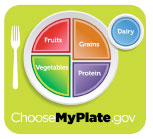
In addition to managing diabetes, it is important to remember to make healthy food choices for good nutrition. Even people who do not have diabetes need to eat a healthy, balanced diet. This includes eating foods from each of the five food groups: grains, dairy, meat and protein, fruits, and vegetables.
Fruits and Vegetables
Try to include different fruits and vegetables at every meal. Fruits and vegetables are not only low in calories, but they have many vitamins and minerals to keep us healthy. They also have fiber, which helps keep us feeling full. Make a goal for half of the plate to be filled with fruits and vegetables at meals.
Dairy
Try to include three servings of dairy each day. Dairy has calcium, a mineral that helps keep bones strong. Milk, yogurt, and cheese are good sources of calcium. One cup of milk is considered one serving of dairy. Low-fat or reduced-fat dairy products can help you keep a healthy weight.
Meats and Proteins
Choose lean meats for heart health. Lean meats include chicken, turkey, fish and ground beef that is at least 90% lean. These items are lower in calories and fat. Meat is a good source of protein and iron to keep strong muscles. Other good sources of protein include beans, lentils, nuts, seeds, tofu, and eggs.
Grains
The best choices from the grains group are whole grains. Whole grains offer more nutrition and are also higher in fiber. Look for items at the store that list whole grains as the first ingredient on the nutrition label.
Portion Size

Portion control is important to help stay at a healthy weight. For example, one serving of meat is 3 ounces, or about the size of a deck of cards. Use the plate model below as a map to help guide portion sizes at meals. For more information, visit www.choosemyplate.gov.
|
Important to Remember about Sweets Remember, someone with diabetes can still have sweets, but should try to eat them in moderation. This means that they should not be eaten every day. Many baked goods, like cake and cookies, have extra sugar. They do not have much nutritional value. Carbohydrates are the body’s main way of getting energy, but it is important to choose healthy carbohydrates, like fruits, veggies, whole grains, and low-fat dairy. These will give the body the best fuel. |
Sweeteners
In the past, people with diabetes were told to stay away from high-sugar foods because they were thought to cause high blood glucose. Now, studies suggest that total grams of carbohydrate are more important than how much sugar is in the food. People with diabetes can now enjoy foods with sugar as long as insulin is given to cover these carbohydrates. However, it does not mean that sweets can be eaten in unlimited amounts!
| Facts to Remember |
| Foods high in sugar are often high in both calories and fat. |
| Most foods high in sugar have poor nutritional value because they are not good sources of vitamins, minerals, and protein. |
| Foods high in sugar are high in carbohydrates; therefore, the portions tend to be small. |
| A food labeled “sugar-free” does not always mean it is “carbohydrate-free”. |
There are several types of sweeteners you can use. The differences between these products are described on the next page.
Artificial Sweeteners
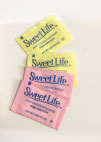
An artificial sweetener does not have calories or carbohydrates.
It will not change blood glucose levels.
Right now, five artificial sweeteners are approved by the Food and Drug Administration (FDA) as safe to eat:
-
Acesulfame-K: Brand names include Sweet-One® and Sunett®. It may be used in cooking and baking. It does not leave an after-taste.
-
Aspartame: Brand names include Equal® and Nutrasweet®. It is proteinbased and leaves no after-taste. It loses its sweet taste after being in high temperatures for long periods of time. This means it may not be the best choice for cooking and baking.
-
Saccharin: Brand names include Sugar-Twin® and Sweet-n-Low®. It comes in a powder, liquid, or tablet form. It may have a bitter after-taste. Use it in small amounts and/or at the end of cooking.
-
Sucralose: Brand name is Splenda®. It is made from sugar. It is stable at high temperatures, so it is good for baking. Sucralose tastes the most like sugar.
-
Neotame: Neotame is not used often in foods. Since it is heat stable, it can also be used in cooking and baking. Not very much is needed to sweeten foods.
The American Diabetes Association states that artificial sweeteners are okay for people with diabetes to use because they are safe for all people.
Sugar Alcohols
Sugar alcohols have less calories and carbohydrate than regular sugar, but they do still have carbohydrates. This means they will still raise blood glucose. They are in “sugar-free” cookies, candy, chewing gum, breath mints, low-sugar granola bars, and even ice cream. They may cause diarrhea or stomach aches when eaten in large amounts because of the way they are digested by the body. Make sure to read nutrition labels for the total grams of carbohydrates, even when foods are labeled as sugar-free. Common sugar alcohols that you may see in a list of ingredients include:
-
Sorbitol
-
Mannitol
-
Xylitol
-
Isomalt
-
Hydrogenated starch hydrolysates
Sugar
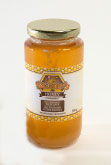
Sugar comes in many forms. All forms have calories and carbohydrates.
Here are some other common names for sugar:
-
Refined sugar
-
High fructose corn syrup
-
Honey
-
Concentrated fruit juice
-
Maple, brown, or powdered sugar
-
Dextrose
-
Agave
Tips for School
School Lunch
It is your choice if you want to take a lunch to school or eat the school lunch.
Here are some hints for school lunches:
-
Visit with school cafeteria staff to find out portion sizes and the substitution policy.
-
Ask for nutrition information for school meals.
-
Find out if the school offers single food items by themselves. Set guidelines for which are okay for your child to choose and when.
-
Review the school lunch menu ahead of time to see which days you may need to pack a lunch from home.
-
If you are packing a lunch, write down the total grams of carbohydrate for the meal and put it in the lunch box. This helps the school staff calculate insulin doses.
Parties at School
Here are some tips for handling school parties:
-
Tell the teacher that you want to know ahead of time when there will be a school party, if possible, and what will be served.
-
Make sure your child’s teacher knows about any foods with carbohydrates that may need insulin coverage. Even something as small as one piece of candy can affect blood glucose.
-
If the school staff cannot give insulin during the time of the party or do not feel comfortable, encourage your child save party snacks to enjoy when he or she gets home.
-
Send “free foods” or desserts with a known carbohydrate count to school for your child and his or her class to eat during the party.
Common Measurements
Liquid (Fluid Ounces [oz.]) Measurements
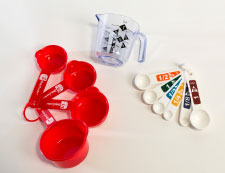
- ½ oz. = 1/16 cup = 1 tablespoon
- 1 oz. = ? cup = 2 tablespoons
- 2 oz. = ¼ cup = 4 tablespoons
- 4 oz. = ½ cup = 8 tablespoons
- 6 oz. = ¾ cup = 12 tablespoons
- 8 oz. = 1 cup = 16 tablespoons
- 16 oz. = 2 cups = 1 pint
- 32 oz. = 4 cups = 1 quart
Weight Measurements
- ½ oz. = 1/32 lb. = 15 grams
- 1 oz. = 1/16 lb. = 30 grams
- 2 oz. = ? lb. = 57 grams
- 4 oz. = ¼ lb. = 113 grams
- 8 oz. = ½ lb. = 226 grams
- 16 oz. = 1 lb. = 454 grams
- 32 oz. = 2 lb. = 903 grams
Other Measurements
- 3 teaspoons (tsp.) = 1 tablespoon (Tbsp.)
- 1/3 cup = 5 1/3 tablespoons
- ?teaspoon = Dash
- ½ teaspoon = 30 drops
- 3 tablespoons = 1 ½ ounces (oz)
- 1 gallon = 4 quarts = 8 pints = 16 cups = 128 oz
Food Logs for Diabetes Management
Some families find food logs to be very helpful, especially when first learning to manage diabetes. There may also be times that a dietitian requests that food logs be kept so they can see how well diabetes is being managed and the overall nutrition.
|
Time |
Record the time you or your child eats. |
|
Food or Bevarage |
Write the specific name of the food eaten. Example:Write ‘1% milk,’ instead of ‘milk.’ |
|
Description of preparation (brand/method) |
Describe the food or beverage your child has eaten.
Example: Mott’s original applesauce or small Shake n’ Bake breaded pork chop |
|
Amount |
Record the amount actually eaten. Use measurements from the charts above.
Example:8oz. skim milk
Example:1 cup, ¾ cup, ½ cup, ¼ cup
Example:1Tbsp., ½ tsp.
Example:17 small grapes
Example:3 oz grilled chicken breast |
|
Carbohydrate grams |
Look on the nutrition label to find the total grams of carbohydrate eaten for each serving. You can also use the Calorie King® book orwww.calorieking.com.
|
|
Calculations |
If you are learning an insulin-to-carbohydrate ratio (ICR):
|
| Important to Remember |
| Write down all the information IMMEDIATELY after eating. It is easy to forget what foods were eaten if you wait until the end of the day to log or record it. |
| Be sure to include drinks. |
| Don’t forget sauces like ketchup, salad dressing, sour cream, and gravy. |
| Make sure to record any nutritional supplements used, like Carnation Instant Breakfast® or vitamins. |
| Use measuring cups and spoons as often as possible. |
| Look at how much is left on the plate. Record only what was actually eaten. |
| Ask babysitters, teachers, or other caregivers to help keep records when necessary. |
| If it is difficult to figure out what to record for a specific food, attach the food label to the logs that will be mailed or faxed to the dietitian. |
| Try to be as specific as possible and write down the food item being eaten, the amount or portion eaten, and the carbohydrate grams. It is also helpful to include specific brand names. |
|
Time |
Food and Beverage |
Description |
Amount |
Total Carb Grams |
Calculations |
|
8:00 am |
Cornflakes |
Kelloggs |
1/2 cup |
16 |
|
|
Milk |
2% white |
4 oz |
6 |
||
|
Orange juice |
100% Natural |
4 oz |
15 |
||
|
Bran muffin |
2 inches around |
1 |
23 |
||
|
10:30am |
Crackers |
Ritz |
6 |
12.5 |
|
|
12:30pm |
Turkey lunch meat |
2 slices deli cut |
1 oz |
0 |
|
|
Bread |
Kroger brand whole wheat |
2 slices |
18 |
||
|
Mayo |
Kraft reduced-fat |
1 tsp |
1 |
||
|
Pretzels |
Rold Gold |
18 |
23 |
||
|
Yogurt |
Dannon drinkable |
1 |
15 |
Back to the Managing Your Diabetes Resource Book Table of Contents »
